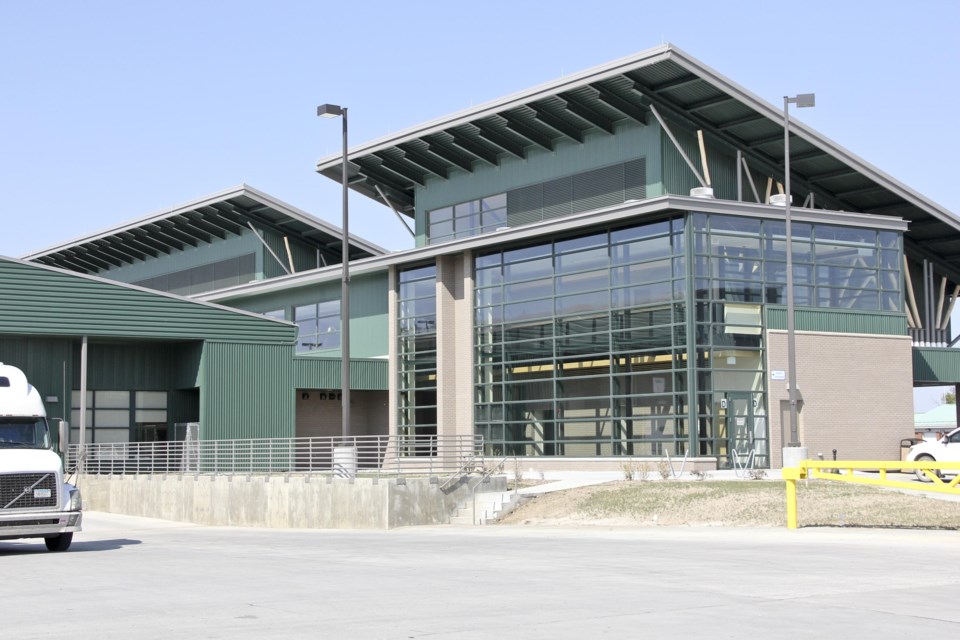Travellers to North Dakota will have certainly noticed the physical changes to the United States port of entry at North Portal.
The port recently received a grand promotion in stature, turning it into the fortress-like compound that now creates quite the shadow for the Canadian port to relax in. With the construction of the new building coming in at 33,000 square feet, the port of entry is now 10 times larger than it used to be.
What exactly is filling this building is what was on display when the Customs and Border Protection (CBP) provided an inside look at the facility and its four buildings on Sept. 5.
What most cross-border commuters will notice is the addition of primary inspection booths. Three will be accessible at all times, and there are an additional two lanes for passenger-vehicle traffic. Brent Beeter, Customs and Border Protection officer, said the additional lanes will open during peak traffic times, on long weekends, and holiday Mondays when a lot of Canadians make a trip south.
Fake owls sit above the booths in order to keep birds from nesting in the overhangs above.
The size of the operation should help process and inspect the 100,000 vehicles and commercial trucks passing through the Portal Port of Entry each year. In 2012, 104,527 passenger cars and 105,330 commercial trucks transited through the port.
Beeter noted they are short staffed right now and hoping to have more personnel coming. Right now they don't have the people to fill the building, so portions are strategically closed off at various times of the day so employees can focus on necessary areas.
The new facility includes a defensive tactics and training area and a gun range. Every three months, all CBP personnel are trained in intermediate force and take part in shooting exercises. Beeter said having a gun range on site is a real luxury after years of having to find a field or gravel pit in the middle of winter to practice.
Brian King, CBP public affairs liaison, said the officers at the primary booths know who is approaching them before they stop because of technology in passports and other documents that signal their system before the vehicle comes to a stop.
"As the vehicle is travelling up to our officer, he or she, has got an idea of who's in that vehicle, if you have the right documents. If it's a Nexus card or a trusted traveler document that would cue in our system and our officer would be aware, before the vehicle even stops, OK I've got two trusted travelers coming into my lane. It gives that officer an idea of what they're dealing with ahead of time."
The yellow pylons commuters will see detect radiation, even trace amounts. Beeter said a lot of what sets them off are medical treatments, including someone who has undergone some cancer treatments. If alarm bells are set off at the primary inspection, drivers are asked to take their vehicles to a second set of pylons where the officer can then identify if radiation is coming from the driver or from the vehicle.
One of the biggest parts of the CBP operation at Portal that most commuters will not see is the rail inspection division, particularly when it comes to agriculture. Regular border crossers know fruits grown in the U.S. and purchased in Canada are not allowed back into the United States.
Ron Melton, CBP's agriculture specialist, said that's because once a product is exported, the U.S. loses track of it. If a product is sitting on a shelf next to produce from another country there could potentially be cross contamination.
"Once it leaves, it's not allowed back in," he said.
The list of what is and isn't allowed to cross is constantly changing, said Melton. A recent addition to the blacklist is tomatoes and peppers due to a disease called mosaic virus.
"They can't come down," said Melton. "This is actually an unfortunate situation. Two years ago tomatoes and peppers from Canada were allowed, and the reason they're not allowed now is because a couple of unscrupulous importers in Canada started bringing in tomatoes and peppers from Belgium, where this virus is found. They started relabelling them as products of Canada and distributed them all over Canada, and then they got caught."
The USDA as a whole, spends about $120 billion every year to try and eradicate invasive and non-native pests.
Beeter said what many people don't realize, because North Dakota is landlocked, is that Portal is still the first point of contact for many imported goods from Asia, Europe and elsewhere. Goods arriving in Vancouver from China are not inspected by Canadian customs because the shipments are bonded and destined for American soil.
From Vancouver, cargo is sent by rail across Canada and isn't inspected until it reaches Portal.
Commercial trucks passing through the port are scanned by the mobile Vehicle and Cargo Inspection System (VACIS), which uses gamma rays to detect possible discrepancies in cargo. Operator Ryan Ziliak likened the scan to an X-ray that uses 1,000 times less radiation than what someone would receive at a dental exam.
He said the operators are looking for colour in wheel wells, on the underside of flatbed trucks and inside the cargo that might identify something that shouldn't be crossing the border.
The port can now process applications for drivers who wish to hold a Free and Secure Trade (FAST) card, which allows expedited treatment at the borders. This is a joint program between the U.S. and Canada. Both countries must certify a driver before he or she can receive FAST membership.




